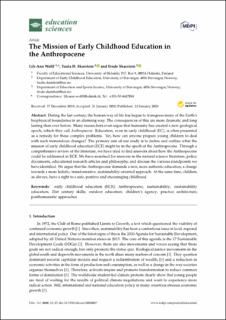| dc.contributor.author | Wolff, Lili-Ann | |
| dc.contributor.author | Skarstein, Tuula Helka | |
| dc.contributor.author | Skarstein, Frode | |
| dc.date.accessioned | 2023-02-08T09:47:25Z | |
| dc.date.available | 2023-02-08T09:47:25Z | |
| dc.date.created | 2020-01-23T10:32:23Z | |
| dc.date.issued | 2020 | |
| dc.identifier.citation | Wolff, L. A., Skarstein, T. H., & Skarstein, F. (2020). The Mission of early childhood education in the Anthropocene. Education sciences, 10(2), 27. | en_US |
| dc.identifier.issn | 2227-7102 | |
| dc.identifier.uri | https://hdl.handle.net/11250/3049165 | |
| dc.description.abstract | During the last century, the human way of life has begun to transgress many of the Earth’s biophysical boundaries in an alarming way. The consequences of this are more dramatic and long lasting than ever before. Many researchers even argue that humanity has created a new geological epoch, which they call Anthropocene. Education, even in early childhood (EC), is often presented as a remedy for these complex problems. Yet, how can anyone prepare young children to deal with such tremendous changes? The primary aim of our study is to define and outline what the mission of early childhood education (ECE) might be in the epoch of the Anthropocene. Through a comprehensive review of the literature, we have tried to find answers about how the Anthropocene could be addressed in ECE. We have searched for answers in the natural science literature, policy documents, educational research articles and philosophy, and discuss the various standpoints we have identified. We argue that the Anthropocene demands a new, more authentic education; a change towards a more holistic, transformative, sustainability-oriented approach. At the same time, children, as always, have a right to a safe, positive and encouraging childhood. | en_US |
| dc.language.iso | eng | en_US |
| dc.publisher | MDPI | en_US |
| dc.rights | Navngivelse 4.0 Internasjonal | * |
| dc.rights.uri | http://creativecommons.org/licenses/by/4.0/deed.no | * |
| dc.title | The Mission of Early Childhood Education in the Anthropocene | en_US |
| dc.type | Peer reviewed | en_US |
| dc.type | Journal article | en_US |
| dc.description.version | publishedVersion | en_US |
| dc.rights.holder | The authors | en_US |
| dc.subject.nsi | VDP::Samfunnsvitenskap: 200::Pedagogiske fag: 280 | en_US |
| dc.source.pagenumber | 21 | en_US |
| dc.source.volume | 10 | en_US |
| dc.source.journal | Education Sciences | en_US |
| dc.source.issue | 2 | en_US |
| dc.identifier.doi | 10.3390/educsci10020027 | |
| dc.identifier.cristin | 1780630 | |
| dc.relation.project | Universitetet i Stavanger: IN-12131 | en_US |
| dc.relation.project | Norges forskningsråd: 275576 | en_US |
| dc.relation.project | Universitetet i Stavanger: IN-10986 | en_US |
| cristin.ispublished | true | |
| cristin.fulltext | original | |
| cristin.qualitycode | 1 | |

